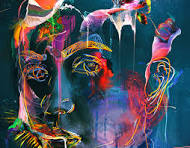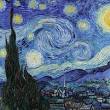The Rise of Digital Artworks
Digital artworks have revolutionized the art world, offering artists a new medium for creative expression and pushing the boundaries of traditional art forms. With the advancement of technology, artists now have access to a wide range of digital tools and software that allow them to create stunning and immersive artworks.
One of the key advantages of digital artworks is the flexibility and versatility they offer. Artists can experiment with different techniques, colors, and styles in a digital environment without the constraints of physical materials. This freedom allows for endless possibilities and encourages artists to explore new artistic horizons.
Furthermore, digital artworks have opened up new avenues for collaboration and interaction within the art community. Artists can easily share their work online, reaching a global audience and connecting with fellow creatives from around the world. This interconnectedness has fostered a vibrant online art community where ideas are exchanged, collaborations are formed, and creativity thrives.
Moreover, digital artworks have blurred the lines between traditional art forms and technology, creating innovative pieces that challenge our perceptions of art. From digital paintings and illustrations to interactive installations and virtual reality experiences, artists are pushing the boundaries of what is possible with digital art.
As we continue to embrace the digital age, it is clear that digital artworks will play an increasingly important role in shaping the future of art. With their ability to captivate audiences, provoke thought, and evoke emotion, digital artworks are not just a trend but a transformative force in the ever-evolving landscape of contemporary art.
Exploring Digital Artworks: Creation, Tools, Authenticity, and Industry Impact
- What are digital artworks?
- How are digital artworks created?
- What tools are used to make digital artworks?
- Are digital artworks considered ‘real’ art?
- How do digital artworks differ from traditional art?
- Can digital artworks be reproduced or duplicated easily?
- Where can one view or purchase digital artworks?
- What impact do digital artworks have on the art industry?
What are digital artworks?
Digital artworks encompass a diverse range of creative expressions produced using digital technology. These artworks are created using digital tools such as graphic design software, 3D modeling programs, and digital painting applications. Digital artists leverage these tools to craft visually captivating pieces that can take various forms, including digital paintings, illustrations, animations, and interactive installations. The digitization of the artistic process allows for experimentation with new techniques, colors, and styles, leading to innovative and boundary-pushing creations that redefine the traditional notions of art.
How are digital artworks created?
Digital artworks are created through a combination of artistic vision and technological tools. Artists use specialized software and digital devices to bring their ideas to life, whether it’s digital painting, graphic design, 3D modeling, or interactive installations. The creative process involves skillfully manipulating digital elements such as shapes, colors, textures, and effects to craft visually stunning and conceptually rich pieces. By harnessing the power of technology, artists can explore new techniques, experiment with different styles, and push the boundaries of traditional art forms to create immersive and innovative digital artworks that captivate audiences worldwide.
What tools are used to make digital artworks?
In creating digital artworks, artists utilize a diverse range of tools and software to bring their creative visions to life. Commonly used tools include graphic design programs like Adobe Photoshop and Illustrator for creating digital illustrations and graphics, 3D modeling software such as Blender or Autodesk Maya for sculpting intricate 3D designs, and digital painting applications like Procreate or Corel Painter for producing realistic paintings. Additionally, artists may incorporate specialized tools like drawing tablets, styluses, and digital cameras to enhance their workflow and achieve desired effects in their digital creations. The combination of these tools allows artists to explore endless possibilities in the realm of digital artistry, enabling them to experiment with various techniques and styles to craft unique and captivating artworks.
Are digital artworks considered ‘real’ art?
The question of whether digital artworks are considered ‘real’ art is a topic that sparks debate within the art community. While some may argue that traditional art forms hold a certain authenticity and tangible quality that digital art lacks, others believe that the creative process and artistic vision behind digital artworks are just as valid and significant. The essence of art lies in the expression of ideas, emotions, and concepts, regardless of the medium used. As technology continues to evolve, so does the definition of art, with digital artworks playing an increasingly prominent role in contemporary artistic expression. Ultimately, the value and legitimacy of digital art lie in its ability to evoke emotion, provoke thought, and inspire creativity, transcending the boundaries of traditional artistic norms.
How do digital artworks differ from traditional art?
Digital artworks differ from traditional art in several significant ways. While traditional art is created using physical materials such as paint, canvas, and clay, digital artworks are crafted using digital tools and software on electronic devices like computers and tablets. This shift in medium allows for greater flexibility, as artists can easily edit, manipulate, and experiment with their creations in a virtual environment. Additionally, digital artworks often incorporate elements of technology and interactivity, offering viewers a dynamic and immersive experience that goes beyond the static nature of traditional art forms. The accessibility and global reach of digital platforms also enable artists to showcase their work to a wider audience instantly, blurring the boundaries between creator and viewer in new and exciting ways.
Can digital artworks be reproduced or duplicated easily?
Digital artworks can be reproduced or duplicated easily due to the nature of digital files. Unlike traditional physical artworks, digital art exists in a digital format that can be copied, shared, and manipulated with relative ease. This accessibility raises questions about authenticity, ownership, and copyright protection in the digital art world. While the ability to reproduce digital artworks offers opportunities for widespread dissemination and accessibility, it also poses challenges in terms of preserving the uniqueness and value of each piece. Artists and collectors must navigate these complexities to ensure the integrity and originality of their digital creations in an era where reproduction is just a click away.
Where can one view or purchase digital artworks?
When it comes to viewing or purchasing digital artworks, there are several avenues available to art enthusiasts. Online art platforms and galleries provide a convenient way to explore a vast collection of digital artworks from artists around the world. Websites dedicated to digital art showcase a diverse range of pieces, allowing viewers to browse and purchase artwork that resonates with them. Additionally, many artists have their own websites or online portfolios where they showcase and sell their digital creations directly to collectors. Art fairs, exhibitions, and virtual reality galleries also offer unique opportunities to experience digital artworks in immersive settings. Whether online or offline, there are numerous options for individuals interested in viewing or acquiring digital artworks to explore and appreciate this innovative form of artistic expression.
What impact do digital artworks have on the art industry?
Digital artworks have had a profound impact on the art industry, reshaping the way artists create, exhibit, and interact with art. The accessibility and versatility of digital tools have democratized the creation process, allowing artists to explore new techniques and styles without the limitations of traditional mediums. Additionally, digital platforms have expanded the reach of art, enabling artists to showcase their work to a global audience online. This interconnectedness has fostered a vibrant community of artists and art enthusiasts, sparking collaborations and conversations that transcend geographical boundaries. Overall, digital artworks have revolutionized the art industry by pushing boundaries, fostering innovation, and redefining what it means to create and experience art in the digital age.



